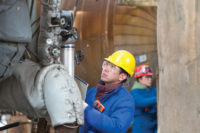3 critical questions to ask about oil and gas industry safety

According to a six-year fatal occupational injuries census conducted by the U.S. Bureau of Labor Statistics, oil and gas workers in the Gulf countries could be up to seven times more likely to be fatally injured than workers in other industry sectors. Commenting on the issue in November 2012, Dr. David Michaels, head of OSHA, said that the industry had “far too many deaths and something has to be done about it.”1
In an attempt to keep workers safer, the oil, gas and petrochemical industry has seen much advancement over the years. Consider the transition from a fall protection belt to an innovative full-body harness with shock-absorbing lanyard, or the addition of a five-minute escape/egress cylinder to an airline respirator, or the evolution of gas detection. Innovations such as these have had a major impact in almost every industry.
Major innovations in portable gas detection
Specific to gas detection, end users in the oil, gas and petrochemical industry accounted for 50 percent of portable gas detector end users globally in 2011, according to Frost & Sullivan’s Global Gas Sensors, Detectors, and Analyzers report. Most manufacturers would likely agree that two major innovations have changed customers’ gas detection programs. The first being the introduction of a docking station which provides end users a way to automatically calibrate and bump test their instruments, as well as keep records.
The second major innovation, “gas detection as a service,” provides visibility into gas detector alarms, exposure and usage. As a safety professional, there are three questions that you must be prepared to answer at all times.
1. What gas hazards are your team members exposed to?
Safety managers and others who are responsible for the health and safety of their employees must know what hazards are faced by workers, when alarms occur, at what levels workers are exposed, and more.
2. Do your gas detectors work properly?
A portable gas detector is a critical piece of equipment meant to save lives. To use it with confidence is to know that it is in proper working condition. The most important elements of gas detector maintenance are bump testing and calibration. These processes are often thought to be too costly and burdensome to perform on a regular basis. However, using a dashboard software that accompanies gas detection as a service, these functions can be made fully automated and then documented. This ensures that your instruments are well maintained, working properly, and will perform as they should in the field.
3. Are your gas detectors being used correctly?
Visibility into employee behaviors related to usage of the instruments in the field is critical. Despite all the advancements in gas detection technology, industrial workers are still dying from exposure to toxic and/or explosive gases. In an organization with a weak safety culture or poor processes, team members might not use their instruments correctly, or might not even use them at all. The stored data within personal monitors worn by employees provides insight into worker behavior. When pairing the data with a software solution, you will know, for example, if an instrument was turned off or ignored by an employee while in alarm.
As stated by Steve Beckett, the behavioral health, safety and environment (HSE) manager for Shell International in The Hague, “If we’re going to get to a situation where there isn’t any harm, where people can feel confident that they can come to work and know that they and their loved ones are going to go home safe, it’s really about human behavior.”2
Newer technologies
With all of the real-time data available regarding workers’ safety, employee location data is often still lacking. In the oil and gas industry, especially, making sure each employee’s location is accounted for can be a daunting task. Consider a pumper in remote mountains; an operator making his safety checks in a refinery surrounded by steel; a pipeline proving truck operator who drives 200 miles a day; a marine transport maintenance operation in the open ocean; or on an offshore roustabout in the deep gulf. If a worker is in danger, it can be difficult to identify their location from a home office and provide the necessary emergency response.
At one refinery in the U.S., a customer decided that, after having two incidents, they had a great need for a lone worker tracking solution integrated with their gas detection program. The refinery solicited the aid of a global management consulting, technology services and outsourcing company that worked closely with the refinery. This company then partnered with a “gas detection as a service” provider and two other leading technology companies for the communications component and the location and tracking component. The system provides real-time tracking of gas readings, alarm events, man-down events, panic button events, and most importantly, employee location data. The tracking device is actually held within the portable multi-gas detector, along with a motion sensor and panic button, thus providing a single device with multiple functions in addition to gas detection.
Another recent development in gas detection is the use of two sensors to detect a single gas in single-gas instruments. The redundant sensor technology overcomes the safety and maintenance challenges of current single-gas monitors. The two sensors sense the same gas and provide simultaneous readings to the monitor electronics that applies a proprietary algorithm to calculate and display a single reading. This technology, in conjunction with a daily self-check that verifies proper operation of the monitor electronics and alarms, makes for a vastly safer and more cost-effective monitor.
Going forward
Despite these advancements, there is still more work to be done in keeping workers safer not only in the oil and gas industry, but across all industries. In order to completely eliminate death on the job, the rapid development of new technologies and strategies is required for keeping people safer at work. And then someday, the headlines will always read “ZERO reported injuries and deaths at work.”
Sources
1 http://www.zawya.com/story/Gulf_oil_and_gas_workers_seven_times_more_likely_to_be_fatally_injured-ZAWYA20130223082014/
2 http://earthsky.org/human-world/steve-beckett-energy-industry-workplace-safety
Looking for a reprint of this article?
From high-res PDFs to custom plaques, order your copy today!







